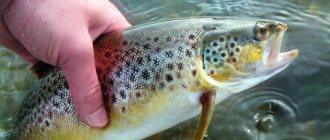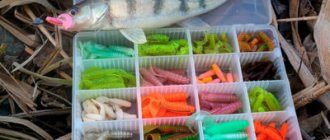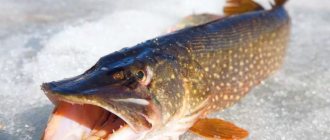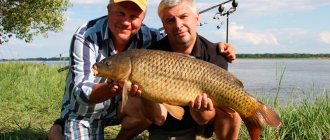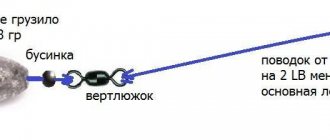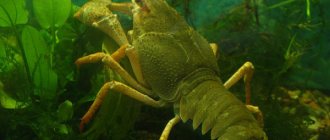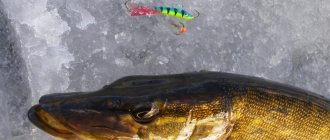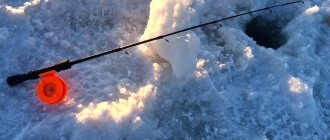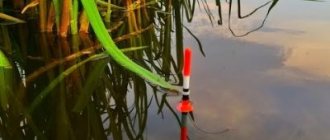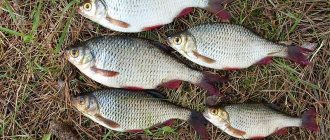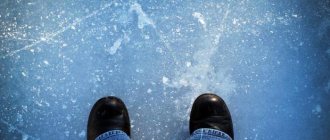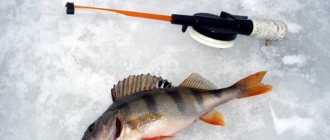Peculiarities of prey behavior
- The indigenous inhabitant of domestic water bodies is brook trout - Salmo trutta, which under certain conditions can reach significant sizes, and such fish are usually called brown trout.
The common pestle, living in small rivers, rarely grows to a weight of 1 kilogram. Usually brook trout is caught in open water, and even then not everywhere, since in some regions its fishing is prohibited. Some enthusiasts continue to catch pied fish in winter, if the river does not freeze, but moving through the snow requires considerable effort. - Much more popular is fishing for rainbow trout - Salmo gardneri, an American invader that thrives in our waters, but does not reproduce in natural conditions.
Therefore, the iris is grown for commercial purposes for subsequent sale in trade, and is also kept in special reservoirs where recreational or paid fishing is organized. Rainbow trout are active throughout the winter and can be successfully fished from the ice. The peculiarities of its behavior on the “pay zones” are determined by the time of release and the food supply in the reservoir. The iris actively migrates through the reservoir in search of food, and does not adhere to any specific layers of water.
The winter behavior of trout forces anglers to approach fishing thoughtfully, using the entire arsenal of available gear and bait, although this is not always possible, since on many “platforms” there are restrictions on the total number of gear used .
A few words should be said about trout that escape from the cages in which they are raised. The reasons for escape can be varied:
- during the current, the net of the cage can break through a passing log;
- In stagnant water, otters often gnaw through nets.
For quite a long time, the fugitive stays close to her previous place of residence. In stagnant bodies of water, fish gradually disperse throughout the entire water area, and in rivers, instinct drives them to where there are rapids. Sometimes fugitives are caught tens of kilometers from the place where they lived in the cage. A characteristic sign of runaway irises is a clipped adipose fin.
Expert opinion
Knipovich Nikolai Mikhailovich
Zoologist, hydrobiologist. I am interested in fishing at a professional level.
Catching a runaway in the current is much more interesting than in a cozy “pay zone”, and besides, you don’t have to pay a very significant amount for fishing.
Trout fishing on paid reservoirs
- VK
Catching artificially bred trout in ponds is already becoming quite common for many anglers. The number of pond fisheries is increasing every year. The first reaction of many fishermen to such an innovation was negative: catching hungry fish (ten tons of which swim in a small pond), ready to rush at any object that falls into the water, has little in common with fishing and is more related to fishing. However, there are also more “sports” reservoirs. They contain a sufficient amount of fish, but not prohibitive, and in addition, there are natural food items (Amur sleeper, bleak, verkhovka). Content:
- FISHING PLACE
- WHERE TO FIND TROUT
- RAINBOW SEASON
- WHAT TO CATCH
- WHAT TO FISH FOR
- ROTATING SPOONS
FISHING PLACE
When choosing a place for future fishing, pay attention to the size and flow of the reservoir, as well as the water temperature. In a flowing and cool body of water, trout feel much more comfortable, therefore they bite better and behave much more actively when fishing. You should not be tempted by the low cost of the trip: most likely, there is some problem with the fish in this reservoir (maybe there is very little of it). In addition, several years ago, pond owners simply fed trout with compound feed, and the trout stopped responding to all other baits. And if the floaters and bottom fish still had some illusory chances of a bite, then the spinners had none left.
The enterprising owners simply shrugged their shoulders at the fishermen's indignation. They say, look for yourself - there are so many fish that almost wash up on the shore. And if it doesn’t bite, then that’s your problem, it means you don’t know how to catch. True, they quickly saw through the trick, and they simply stopped going to such ponds.
If a spinner fished well somewhere, he will certainly tell his friends (especially since this is a “pay zone” and not a hidden point on the river), and next time ten times more fishermen will come there, and accordingly the profit will be much higher - after all, they will pay not only for the ticket, but also for the fish.
Moreover, most of the owners, even during a telephone conversation, began to provide quite reliable information about the bite: for example, last spring I called a dozen “paying sites” for the sake of the experiment, and all but one (it should be noted that by that time the weather had already been very hot for a week ), I was not advised to come for trout - there is practically no bite. Only in one farm, where all ponds have a large number of bottom springs, it was reported that trout were quite active.
WHERE TO FIND TROUT
Trout in ponds usually have little attachment to vegetation or snags, of which there are few. If you carefully observe the school with polarized glasses, you can see the peculiar route along which the trout circulates along the shore. Having found several points where trout approach the shore, you can go around them one by one and systematically fish. There is another option: carefully inspect the water surface and, noticing the breakers and excitement from the school’s emergence into the surface layers of the water, immediately throw bait there (in much the same way as when catching perch or asp in a “cauldron”).
In addition, at any time of the year (but especially in the heat), trout gravitate towards the springs. If their exact topography is known and you manage to throw the bait to such a point, this is an almost 100% guarantee of a catch. Should you camouflage yourself when fishing for pond trout? Probably, such camouflage methods as when catching wild moths are not necessary, but you should not clearly stand out against the sky, especially when fishing from the bridge, make too much noise and wave your rod.
RAINBOW SEASON
Trout prefers cool and running water, so the best seasons for fishing are spring and autumn, when the water has not yet warmed up or has already cooled down. In summer you can also fish quite successfully, but it is better to focus on flowing or aerated ponds. Trout also become active during prolonged bad weather, such as long rains with cold weather. The most attractive season is spring. Since fishing with a spinning rod is prohibited during spawning in ordinary bodies of water, a spinning angler yearning for fishing has only two options: either deliberately break the law and fish with a spinning rod on a river or lake, or go to a “pay zone” where there are no prohibitions.
WHAT TO CATCH
Trout is a very lively and strong fish. However, you should not deprive yourself of pleasure and choose overly powerful gear. In my opinion, on a small body of water it is quite enough to use a light class rod. And only on large lakes do you have to take a longer “stick”, since trout often concentrate at a distance of 50-60 m from the shore and you can’t reach it with a short rod. The reel is also small, the optimal size is 2000 according to the Japanese classification, for example Ryoby Zauber. The choice of fishing line is a matter of taste. Fishing for trout does not require its hyper-sensitivity, such as fishing with jig baits, so the use of multifilament lines is completely unnecessary. However, I prefer thin “braid” with a tensile strength of up to 5-6 kg. In combination with a rod with a moderate or slow action, the number of trout catches is no more than when using a monofilament. Many spinning anglers claim that trout are afraid of braided line, but I have never received reliable confirmation of this fact, even when fishing with bright red or yellow “braid”. Nevertheless, in this situation it is quite possible to use “braid” of faded tones - the visibility of the cord does not play a big role, since the bite is quite felt by hand, and control of the wiring is, as a rule, simple. Naturally, no leashes are required if there is no pike in the pond.
WHAT TO FISH FOR
Having tried almost the entire arsenal of a wide variety of baits, I settled on a few that help me out in almost any situation and on any body of water. Wobblers. Trout bite on wobblers of any class and type, but minnow and rattlin seem to me to be the best and most convenient. My observations show that, even when trout are predominantly in the surface layer of water, they respond better to baits going at a depth of 4050 cm. Therefore, sinking minnows and suspenders are more suitable (and such baits fly further when cast). Don’t get carried away with too large wobblers; a reasonable maximum is 80-85 mm. The one I use most often is the Masu Masters MM 58; River2Sea Valor 75 and Sock 85; C'ultiva Rippi'N'Minnow RM 70. If the original is a floating model, then it is worth replacing the tees on it with slightly larger ones, then the trout will be better hooked, and the wobbler will become sinking. It is worth noting that it is minnow wobblers that are the “record holders” for catching trout. It happens that for a couple of “correctly” caught trout, three or four are caught with their belly or tail. Taking this into account, many spinning anglers generally refuse to use jerk baits on hotbeds, despite their high catchability.
Since almost all of the listed wobblers are deprived of their own game, the only method of their animation is jerking, most often twitching. It is absolutely impossible to plan the “aggressiveness” of the wiring (that is, the strength and amplitude of the jerks). It happens that trout react only to sluggish movements of the wobbler, and sometimes, on the contrary, they clearly prefer frequent and sweeping jerks, as if when fishing with jerkbaits. Therefore, I cannot say that there is any type of preferred jerk for pond trout. Each time you have to select it according to the “mood” of the fish.
Any other methods of wiring, as well as other baits during such a “spinning wilderness” turned out to be ineffective. Pond trout in most situations clearly prefer wobblers of bright, “acid” colors. I don’t presume to judge what’s going on here. Perhaps bright orange, red and green colors have some special appeal to the trout's vision. In the last two years I have been fishing for trout almost exclusively with acid baits. This does not mean that it is not caught at all with baits of natural colors, however, in most situations, my catches are clearly better with baits of bright colors. Moreover, this applies to wobblers, oscillating and rotating spoons. A safe rattlin-type wobbler is a bait that, in my opinion, should definitely be in the arsenal of every spinner, especially if he is going to fish for trout in a large body of water. The rumble of such a bait can attract fish from a very long distance, especially when fishing in clear water. As soon as you cast the rattlin and start retrieving, curious trout begin to swim towards it from a distance of 10-15 m; they poke their noses at him, accompany him, then he suddenly disappears, and the rod bends into an arc.
The wiring required is the simplest - uniform, at a depth of about 0.5-1 m. The speed must be selected so that the bait goes at the desired depth, without sinking or coming to the surface. To do this you need to have rattlin'bi of different masses. Sometimes this technique works: after casting 11.5 m, the wobbler is driven evenly, and then the wiring is stopped, and the rattlin begins to sink. As a rule, a bite follows after a second or two. Most often I use A-elita Vib (7 and 21 g); Berkley Frenzy and Masu Masters MM Vib 38 (this miniature wobbler in the “noise” version is a real “magic wand”: even with the worst bite, you can always “force” one or two tails on it). The Vib 38 has two drawbacks - small tees and a small mass, which limits casting range, but basically it is, in my opinion, an ideal bait for “wise” trout.
ROTATING SPOONS
My favorites are bright and compact lures. There are no special requirements for “turntables”, other than ease and stability of rotation at the lowest wiring speeds. Most often I fish with Vibrax, Heron and Mosca Graffy (the best color is bright orange with black stripes). Spinner baits are good because they allow a slow retrieve, which trout often like.
Another advantage is that with “spinners” you can use various attractants, to which trout are far from indifferent. I have long preferred the Mega Strike - the trout like it and it holds well on the lure. It is best to apply the attractant to the edge of the tee. But the best option is to use special spinners adapted for the use of attractants.
Berkley has a whole line of ScentVent spinners, which have a core made in the form of a plastic lattice; the gel-like Mega Strike stays on it very reliably, and one “fill” is enough for several fishing trips. One such spinner with a rainbow petal, treated with Mega Strike, regularly seduced trout for a week on one of the paid reservoirs within Moscow against the backdrop of a total lack of biting, and the fish ignored all other baits, only occasionally falling for a float rod with corn and shrimp attached.
With wobblers and spinners in the box, you can consider yourself fully equipped to go to the trout pond. However, the trout does not miss and very willingly bites on oscillating spoons (usually small in size; Kamlooper from Acme shows very good results), jig baits (twisters, rippers, etc.), which are best not led along the very bottom, like, say, when fishing for pike perch, but half-water. Trout can also be caught in the bottom layer, but mid-water bites occur much more often.
Another type of lure that trout like is bladebaits. Lures, frankly speaking, are not for everyone, but it would be unfair not to mention them, especially since I catch trout with them at least half the time. Their wiring is the same as rattlin class wobblers - uniform or slightly wavy in the surface layer or at half-water. Despite the fact that the vast majority of lures of this type do not have acoustic elements (with the exception of Sonara and Flappin' Sonic), trout clearly focus on bladebaits and actively attack them. The big advantage of bladebaits is that they have several holes for attaching fishing line (by simply rearranging you can radically change the frequency and amplitude of their oscillations without changing the speed of the retrieve), as well as their compactness, which significantly increases the casting distance.
Out of quite a large number of different models, I mainly use three: this is the old DAM model (clone of the American Gay Blade) and the Japanese ones - Little Max (Evergreen) and my favorite - Flappin' Sonic (Imakatsu). The latter has a metal tail, which has not only a decorative function: if you remove it, the fish begins to bite worse (and not only trout, but also perch). However, both “Japanese” ones need a little tuning if you are going to catch trout with them.
In the original version, both bladebaits are equipped with double hooks with stings pointing backwards, which reduces the number of hooks, but these hooks hook trout poorly and unreliably. We fish in half-water, so we don’t have to think about hooks, but the slips are very frustrating, so we replace double hooks with small treble hooks - this doesn’t affect the performance of the bait in any way, and the number of empty hooks and slips is reduced by an order of magnitude.
A FEW LITTLE THINGS
Trout are severely injured when fishing, so the vast majority of reservoir owners prohibit releasing caught fish back. Therefore, you will have to take care of the safety of the trophy.
After catching, you must immediately euthanize the trout (a fishtoter, or priest - a stick with a special knob, will help you do this), and then it is better to gut it and put it in a cool place (for example, in a car refrigerator or a thermal container with cold batteries). There it won’t freeze, but it won’t spoil either; and when you arrive home, it’s better to immediately prepare your trophy - the most delicious trout is chilled, not frozen.
Related articles:
Plug donka
Bluefish fishing
Silver carp fishing
Donka fishing from a boat
Tackle – what to fish with from the ice?
The following types of gear are used to catch rainbow trout from ice.
Zherlitsy
For catching iris from ice, ordinary pike rigs are quite suitable if certain changes are made to them. No metal leash is needed. The thickness of the main line must be at least 0.4 mm. A fluorocarbon leash with a diameter of 0.3-0.35 mm is tied to its end. The rig ends with a single hook.
Postavushi
Postavushi are passive type baitfish that do not have a bite alarm. The supplies are checked from time to time to remove any caught fish and update the bait. The bait must be held firmly on the hook, so shrimp and trout paste are ineffective; it is optimal to use live bait or pieces of fish.
Fishing rods with a nod
There are two types of nod fishing rods:
- powerful stationary;
- and easier for fishing with a jig with play.
A stationary fishing rod must be powerful enough and have some kind of device for stable installation on ice.
Expert opinion
Knipovich Nikolai Mikhailovich
Zoologist, hydrobiologist. I am interested in fishing at a professional level.
Trout can easily pull the fishing rod into the hole if the angler is hesitant. By putting a ruler of sufficient length on the whip, you can avoid such trouble.
The nod on a stationary fishing rod should be clearly visible so that the angler, even while engaged in another type of fishing, can notice the bite. It is welcome to equip your fishing rod with a reel with a primitive drag.
A fishing rod for jig fishing should have a shape that is comfortable to hold. When biting, the reel can release a small amount of fishing line. The nod must be designed to allow the required play to be performed. Typically, nods made of metal springs are used. The fishing line used is not as thick as in previous cases, since it will be quite difficult to give the jig an attractive game with such a fishing line.
Float
Float tackle has no significant differences from a fishing rod with a nod. The difference lies in the equipment. When catching cautious trout, it is possible to balance the sinker and float so that the latter will show even a weak bite, and the fish will not be wary. When the bite is active, it makes no sense to use float tackle.
Tackle for trolling
The tackle for trolling is a powerful fishing rod with a reel, also equipped with something like a clutch. The required amount of monofilament with a diameter of 0.35-0.4 mm is wound onto the fishing line, and at the end a fluorocarbon leash with a fastener is tied.
What they bite on: lures for winter fishing
Animals
The main animal baits for trout fishing are the following:
- Shrimp. Most often, boiled-frozen shrimp from the store is used, but raw and freshly boiled shrimp can be used. The back of the crustacean with a piece of shell is placed on the hook.
- Worm. Earthworms and crawlers are most often used.
- Maggot.
- Bloodworm.
- Live bait. Small fish are used as live bait: small roach, verkhovka, dace.
- Pieces of fish - cutting - narrow strips of fish fillets.
Expert opinion
Knipovich Nikolai Mikhailovich
Zoologist, hydrobiologist. I am interested in fishing at a professional level.
Shrimp is considered the #1 bait for catching rainbow trout in both summer and winter. But this bait is also to the taste of other underwater inhabitants: roach, perch, bream. Therefore, in order not to waste time catching unnecessary fish, it is better to use artificial bait.
Vegetable
Trout paste can be called a vegetable bait, since its basis is made up of carbohydrate components.
At the same time, a significant part of it consists of various protein additives, including aromatic ones. Canned corn, considered a delicacy for the iris in the summer, is ineffective in the winter.
Artificial
The main artificial baits for catching rainbow trout from ice are the following:
- balancers;
- VIBs;
- summer oscillators;
- winter vertical spinners.
Among the balancers, the most catchy ones are the well-known Rapala, Kuusamo and Nils Master. The size of the baits is 5-7 centimeters.
The most catchy baits for winter trout are summer Kuusamo Professor and Rasanen spoons of the smallest size.
Expert opinion
Knipovich Nikolai Mikhailovich
Zoologist, hydrobiologist. I am interested in fishing at a professional level.
Since trout is a very strong fish, all elements of bait equipment should be replaced. This applies to both tees and winding rings.
Oscillating and rotating spoons for trout fishing
Spinnerbaits and spinners perform best on active and semi-active trout in warm water, when fast retrieves and strong movements of the bait are required.
Small spoons perform especially well in deep meadow streams with a small current. They fly well, dive quickly, and play well on fast and medium retrieves.
The following characteristics of spoons are important for trout fishing:
- Small size
- Quality game
- Bright and natural colors: yellow, red, green, pink, gray, dark, brown, and the colors of various beetles.
The choice of spinner size depends on the expected size of the trout. It is natural that the smaller the bait, the more often there will be bites, but at the same time smaller fish will be caught.
From experience, we will say that a 4-5 cm spoon is good for a half-kilogram trout, 6-7 cm for a kilogram trout, and up to 9 cm for a trophy trout. But there can always be exceptions. Micro-oscillators 4-5 cm long are usually used.
You can find out the current prices for various baits in the fishing online store.
Of the most popular trout baits, we note the following:
- Smith Pure 3.5g
- Forest Miu
- Daiwa Crusader
- Daiwa Presso Skinny Spoon
- Skagit Designs PriSpoon
- Bassday Kangoku Raptor
Daily and weather patterns
The most promising times for fishing are considered to be morning and, to a lesser extent, evening hours.
During the day the bite is much worse. Trout can actively bite in any weather, but depending on the level of atmospheric pressure, it changes the horizon of its presence in the water, and this should be taken into account when fishing.
Where to look for prey in winter?
When fishing on “platforms” you can encounter two “populations” of trout: freshly released and “resident”. The fish that were recently released rush around the reservoir in search of the best feeding places. You can catch such trout anywhere – in any area of the “pay zone” and in any layer of water.
Fish, launched a long time ago, stick to certain areas of the reservoir. As in most other water bodies, the most attractive areas for fish are bottom areas with various relief anomalies:
- pits;
- rocky banks;
- flooded snags, etc.
However, this does not mean at all that in such places the trout stays near the bottom. Fish move around their hunting areas not only horizontally, but also vertically.
Usually, at paid sites, the owners of the reservoir themselves tell the fisherman where to look for fish. Indirect signs of promising places are numerous yesterday's holes or clusters of previously arrived anglers.
Finding catch points
“Platniki”, like any reservoirs, have their own specifics, and, first of all, they relate to the topography and promising points where fish are concentrated. For example, in “Kuvak” a rectangular pond is located in a lowland. It was dug twelve years ago and has a simple topography. What does it mean? Each side goes smoothly into the depths at a certain angle, and the entire central part of the reservoir has a flat bottom, but there are a small number of small holes and hillocks, and it is difficult for beginners to detect them.
In general, if this is your first time on a paid reservoir and you don’t know the terrain, then fish the corners first. The fish always stay in them. But don’t think that you will come to the corner and immediately get caught. Bites here happen sporadically. Trout definitely need to move; it moves literally in a circle, from one corner to another. If at the beginning of autumn a couple of minutes is enough for her to swim from one corner to another, then in icy water this time increases many times over.
Fast movements are fraught with unnecessary loss of energy, which is why the freckled swimmer swims slowly and imposingly. Other promising locations are walkways. But not those on which fishermen stand, but bridges across the pond, with the help of which you can cross to the other side. They stand on supports, and these supports attract fish. And, probably, the most interesting places include “bubble tanks”, aerators and clean water drains into the pond.
In “Kuvak” both the aerator and the drain are located in one place. Often on weekends, spinners come here two hours before the opening to stake out this site. Since this body of water is located three hundred kilometers from me, I usually come to a head-to-head analysis, and I have to focus either on the corners, or “lick” the bottom and look for unevenness in the relief. But if I was lucky, I ended up being stocked with fish, but, alas, there were only two such cases in my entire practice. Well, and finally, the last promising place in late autumn will be the edge of the ice. In the last days of November, some part of the reservoir is hidden under ice, and fish stand right on the border of open water and ice, so casting under the ice crust is always relevant.
To summarize, the main fishing points are pond corners, aerators, drains, anomalies on the bottom of the reservoir (pits, “navels”) and the ice edge. Now that I understand where to look for the most promising points, fishing on the Kuvak has become much easier for me. Let's move on to tactics, but here everything is much more complicated.
Fishing on “paid platforms” - what is it?
Fishing on “paid platforms” assumes that an angler who pays a certain amount will be able to catch a certain amount of fish, which he will also subsequently pay for. At some paid reservoirs you can rent gear. In addition, services for a comfortable stay are usually provided - from barbecues to warm houses.
It is prohibited to release caught fish. On some “pay sites” there are offers according to which a fisherman, by paying a certain amount, can catch 10 kg of fish, which costs him much less than paying for each fish caught. But not everyone can accomplish such a task.
Expert opinion
Knipovich Nikolai Mikhailovich
Zoologist, hydrobiologist. I am interested in fishing at a professional level.
Another advantage of “paying” is the location at a short distance from large cities with good access roads.
Advantages of paid reservoirs
When visiting paid trout reservoirs, some misers often regret the money spent on fishing. However, in some cases, anglers get more advantages by choosing artificial waters than when fishing for trout in natural conditions.
- Firstly, trips to remote bodies of water as a result become much more expensive than fishing in your own city or region.
- Secondly, many paid reservoirs are equipped with comfortable houses, bathhouses and parking lots. When preparing for fishing, you need to take only gear and the most necessary things. Beginner anglers will love this type of vacation.
- The banks of paid reservoirs are well equipped; the fishing spots are small bridges. They can easily accommodate a fisherman with all his luggage.
- Platniks are available in many large cities, so most fishermen go on vacation in the company of friends.
- Trout fishing can be done both during the open water season and in winter. Typically, ice fishing brings prey in the form of small fish, and extracting a noble pied from a hole will be a memorable event.
- On paid reservoirs, trout behave actively and predictably. The fish are not negatively affected by factors such as the thermocline and changes in water level, humidity and atmospheric pressure.
The most suitable weather for fishing will be a sunny day, although trout can bite in the rain.
Secrets of tactics and technology
For spinners
The tactics for catching iris on “platforms” is to search for promising places for its hunting, while the runaway is usually caught next to the cages from which it escaped.
For successful trout hunting, a winter echo sounder from the “Practician” series can become an indispensable assistant. It will show what horizon the fish is on and how it reacts to bait.
The fishing technique is a sequential fishing of layers of water from the bottom to the surface. You shouldn’t fish on one horizon for a long time – just make a few strokes. If the depth at the fishing site is excessively large, then the bottom horizons are not fished - trout usually do not stay there. With a good bite, you can determine the most promising horizon for fishing, although other layers of water should be checked periodically.
Na postavushi
They are installed at different depths and checked periodically.
To the balancers
They fish with balancers in the same way as with spinners and VIBs, only the technique of playing with the bait differs.
To the girders
The zherlitsy are placed in the permitted quantity, making different holidays on different zherlitsy. You need to carefully monitor the bait, not because effective hooking is needed (trout usually swallow the bait), but to prevent the fish from unwinding too much line, thereby complicating the process of fishing.
Expert opinion
Knipovich Nikolai Mikhailovich
Zoologist, hydrobiologist. I am interested in fishing at a professional level.
When fishing for rainbow trout using any type of gear, fishing should be done forcefully. The structure of the trout's mouth is such that if the bait is not swallowed whole, escapes occur quite often. A small hook will not be at all superfluous for dragging prey into the hole.
On a nodding fishing rod
You should closely monitor the nods of the fishing rods and make the hook in time. In most cases, the trout will grab the bait without thinking, but if something worries the fish, it may spit it out. In such a situation, hooking will not be superfluous.
On the float
The technique of fishing with a float rod is similar.
On the jig
The principle of fishing with a fishing rod and jig using one or another bait is the same as when using lures, i.e. sequential fishing of different horizons. Playing with a jig should be smooth.
On the running donka
Running trout in the current can be caught using a running donka. The equipment consists of a diverting leash with a sinker of such a mass that allows it to gradually move from the hole downstream. As bait, they use some kind of animal bait or edible “rubber,” which the iris considers a delicacy.
What is the best way to catch trout? Bait for trout fishing
What is the best way to catch trout depends directly on the choice of gear. On this site you will find bait or bait for trout fishing with any tackle and no matter how you plan to catch it. It is important to know that in spring and summer, trout fishing will be more effective on insects, worms, corn, etc., but trout’s predatory instinct awakens closer to autumn, so trout fishing with spinning rods and live bait will be most effective in the fall.
When fishing for trout with a float rod, the following baits are mainly used as trout bait:
- muckworm;
- earthworm;
- maggots, bloodworms and other insect larvae;
- dead fish or live bait;
- Red caviar;
- corn;
- cheese;
- flies.
These are the baits that have shown themselves especially well when fishing for trout using a float rod. In many reservoirs, trout go great with red caviar , although, of course, not every angler can afford to use such bait for trout
